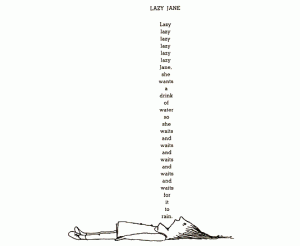Last month, Vulture ran a piece where eight museum directors of such ivy-league museums as Art Institute of Chicago, the Guggenheim, etc. shared their favorite pieces of art. It got me thinking about how we come around to art, and as always, what the hell art is anyway. Obviously, we at WWAC have a pretty wide definition of art–as is needed when you love a medium considered “low brow.” I turned to some of our staff to ask: what was the first work of art that left an impression on you?

Romona recalled an “aha” moment when her first grade teacher read Shel Silverstein to the class:
“It surprised me to find out that words that rhyme could count as poetry; that such an adult sounding topic was that simple. Poetry was happening when our teacher read that fun looking book out loud, ridiculous pictures and all. That was when I first realized anyone could do art/writing.”
I imagine many of us, particularly comic book lovers, can recall similar experiences. The simple lines and shapes of Shel Silverstein certainly influenced me as did Charles Schulz’s Peanuts. Kid’s books are loaded with delightful combinations of images and words on pages, yet their intended audience renders them inferior and not “art.” Yet, I read concrete poetry (aka shape poetry) in my college literature classes. How different are the two, really? Shel Silverstein combining poetry, concrete poetry, and illustration or Mary Ellen Solt’s poems in the shape of flowers?
Rachel recalls her first aha moment occurring when looking at a Crayola magnet:
“The first thing I remember reading/interpreting and understanding was a Crayola magnet–it was sculpted to look like a crayon box with different colors in it. I recognized the word and what it signified. A piece of art representing tools made to create art, that feels appropriate for me.”
Unlike Rachel, I didn’t see such things as art though I certainly admired them. I drew relentlessly as a child. Drawing lines, destroying paper when something wasn’t working, killing so many trees because recycling was still a weird hippie thing at the time. I voraciously read Archie comics and scoured the internet for Sailor Moon images because I couldn’t find the manga in my hometown. I aspired to the fashion photography decorating the magazines along the racks in the grocery checkout line. But I never thought to consider any of it “art.” I knew enough to know it wasn’t supposed to be art. And I knew intuitively “art” was not easily accessible to a working class girl living in a small, rural town. I certainly appreciated pictures of great artwork by the likes of Da Vinci, Rembrandt, etc. which is why I took Art History I instead of art appreciation in college. I already appreciated art; I didn’t need a damn class in it. I ended up taking Art History II: The Renaissance to Modern Art as an elective and that is where I encountered the fauvists. The fauvists set the definition of art in motion for me.

Fauvism was a post-impressionism movement often considered a part of expressionism. Like impressionism, it was often still representational, but it valued the painterly over realism. Matisse is often considered a fauvist. While fauvism is now fully institutionalized and disciplined within art history, this was not always the case. Fauvism was radical, a huge departure from art at the time, following closely on the heels of impressionism. Today, it’s pretty hard to imagine anyone declaring Claude Monet radical. Reprints of Monet’s work now decorates the pastel walls of nursing homes and hospitals, but hey, at one time, Water Lilies was radical.

Fauvism represented a sort of midpoint for me in my understanding of art. Modern art had previously held no appeal to me because I couldn’t understand it. Essentially, I had to understand modern art intellectually before I could connect with it. But Fauvism did not ask that of me, and it opened up my intellectual and emotional understanding of art and set the groundwork for my love of Franz Marc, Kandinsky, and the abstract expressionists. Fauvism taught me art can mean and be so much more so when I see something like Christian Ward’s art and colors in ODY-C, I know that’s art.*

*Correction: Originally, this read “Fauvism taught me art can mean and be so much more so when I see something like Christian Ward’s art and Dee Cunniffe’s coloring in ODY-C, I know that’s art.* Christian Ward informed me via Twitter that he does his own colors while Dee Cunniffee is the flatter. You can learn more about the process here. 2/10/15

